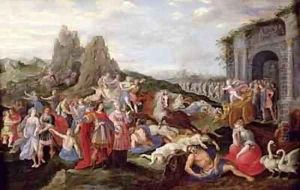Frans II the Younger Paintings
Frans Francken the Younger was a Flemish painter who was born in Antwerp in 1589 and died in the same city in 1667. He belonged to the Francken family, a dynasty of artists that had a significant influence on the Antwerp art scene during the late Renaissance and early Baroque periods. Frans II was the son of Frans Francken the Elder, and his brothers Hieronymus and Ambrosius Francken were also painters. He was known for his distinct style and contributions to the development of the Flemish painting tradition.
Frans II trained under his father and later became a master in the Antwerp Guild of Saint Luke by the age of 21. His work is characterized by a keen attention to detail, vibrant colors, and a skillful handling of light. He was versatile in his subject matter, producing historical paintings, allegorical scenes, genre works, and still lifes. Francken was particularly renowned for his cabinet paintings—small, intricate works that were collected by wealthy patrons and displayed in their private cabinets of curiosities.
He contributed to the popularization of certain themes such as the Witches' Sabbath, the Triumph of Neptune and Amphitrite, and the Seven Works of Mercy, often imbuing them with a sense of narrative and drama. Francken also collaborated with other artists, providing figures for the works of landscape painters like Jan Brueghel the Elder.
Frans Francken the Younger's work reflects the transition from Mannerism to Baroque and highlights the increasing interest in secular themes alongside religious ones. His paintings were sought after by collectors throughout Europe and had a lasting impact on the art of the Southern Netherlands. His workshop was one of the most prolific in Antwerp, and his influence extended to his pupils and followers, ensuring the continuation of his stylistic legacy.



